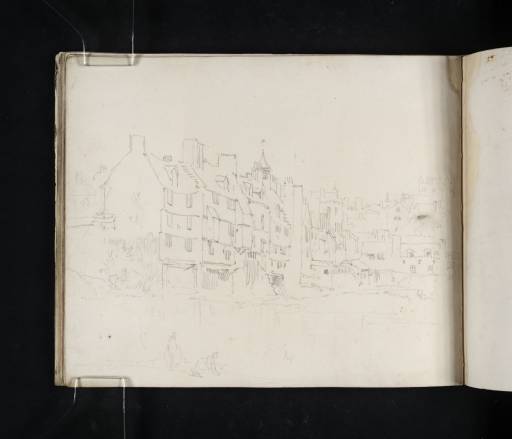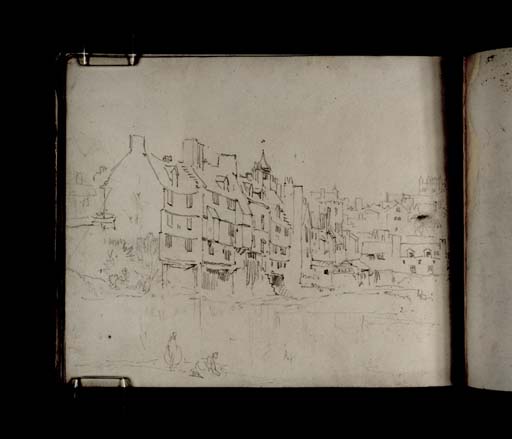Joseph Mallord William Turner Exeter: Houses and St Edmund's Church on the Exe Bridge below the Cathedral 1811
Image 1 of 2
Joseph Mallord William Turner,
Exeter: Houses and St Edmund's Church on the Exe Bridge below the Cathedral
1811
Joseph Mallord William Turner 1775–1851
Folio 30 Verso:
Exeter: Houses and St Edmund’s Church on the Exe Bridge below the Cathedral 1811
D08842
Turner Bequest CXXIV 30
Turner Bequest CXXIV 30
Pencil on white wove paper, 170 x 209 mm
Inscribed by Turner in pencil ‘[?Riv’] bottom centre
Blind-stamped with Turner Bequest monogram bottom centre
Stamped in black ‘CXXIV – 30’ bottom right on the recto (see discussion below)
Inscribed by Turner in pencil ‘[?Riv’] bottom centre
Blind-stamped with Turner Bequest monogram bottom centre
Stamped in black ‘CXXIV – 30’ bottom right on the recto (see discussion below)
Accepted by the nation as part of the Turner Bequest 1856
References
1909
A.J. Finberg, A Complete Inventory of the Drawings of the Turner Bequest, London 1909, vol.I, p.354, CXXIV 30, as ‘Exeter, with Cathedral in distance’.
1974
Gerald Wilkinson, The Sketches of Turner, R.A. 1802–20: Genius of the Romantic, London 1974, reproduced p.126, as page ‘30a’.
At the centre is the small church spire of St Edmund’s-on-the-Bridge, visible above buildings on the east side of the bridge. The church was rebuilt in the 1830s,1 but was damaged by fire in the 1960s and largely demolished apart from two storeys of the tower.2 A drawing of about 1827, attributed to Arthur Glennie, shows the stone bridge from the west, with ramshackle houses built out on wooden supports and the church tower with its distinctive spire (Westcountry Studies Library, Exeter). In a retrospective list, Joseph Farington noted that he had made a ‘South view of the old buildings grouped with the Bridge Church tower’ on his own West Country tour in Autumn 1810,3 when he visited many of the same sites as Turner (see also under folio 32 verso; D08846).
Two figures are shown on the southern bank of the River Exe, now a landscaped embankment north of Alphington Street. The spans which actually crossed the river had been demolished in 1788 when a new bridge was built upstream, leaving a portion of the late twelfth-century bridge standing above marshland. The buildings on it other than the church are long gone, but the bridge has been restored to a degree and survives marooned in a park within a network of roads between New Bridge Street and Western Way.4 In the distance on the right are the twin transept towers of Exeter Cathedral, roughly half a mile away to the north-east. Owing to World War II bombing and redevelopment, barely anything from Turner’s time remains in between.
Turner had not used this sketchbook since drawing Lyme Regis from Charmouth (see folio 29 verso; D08841), over thirty miles back on his route along the Devon Coast, in the meantime using the smaller Devonshire Coast, No.1 sketchbook (Tate; Turner Bequest CXXIII). There are further Exeter views on the versos of folios 31, 32 and 33 (D08844, D08846, D08848).
This page was recorded by Finberg as if it were a recto (without the ‘a’ suffix by which he usually indicates a verso), but the drawing he describes is bound as the verso of the sheet and stamped on the blank ‘recto’. When Tate accession numbers were allocated to the book the verso (i.e. the present drawing) was originally designated as D08843, but the number was cancelled as redundant.
[David Cornforth], ‘St Edmund’s, Exe Bridge’, Exeter Memories, accessed 4 March 2009, http://www.exetermemories.co.uk/EM/_churches/stedmunds.php ; see also Andrew Saunders, Devon and Cornwall, Exploring England’s Heritage, London 1991, p.104.
Technical notes:
The torn top right corner has been made good.
Matthew Imms
February 2011
How to cite
Matthew Imms, ‘Exeter: Houses and St Edmund’s Church on the Exe Bridge below the Cathedral 1811 by Joseph Mallord William Turner’, catalogue entry, February 2011, in David Blayney Brown (ed.), J.M.W. Turner: Sketchbooks, Drawings and Watercolours, Tate Research Publication, December 2012, https://www


